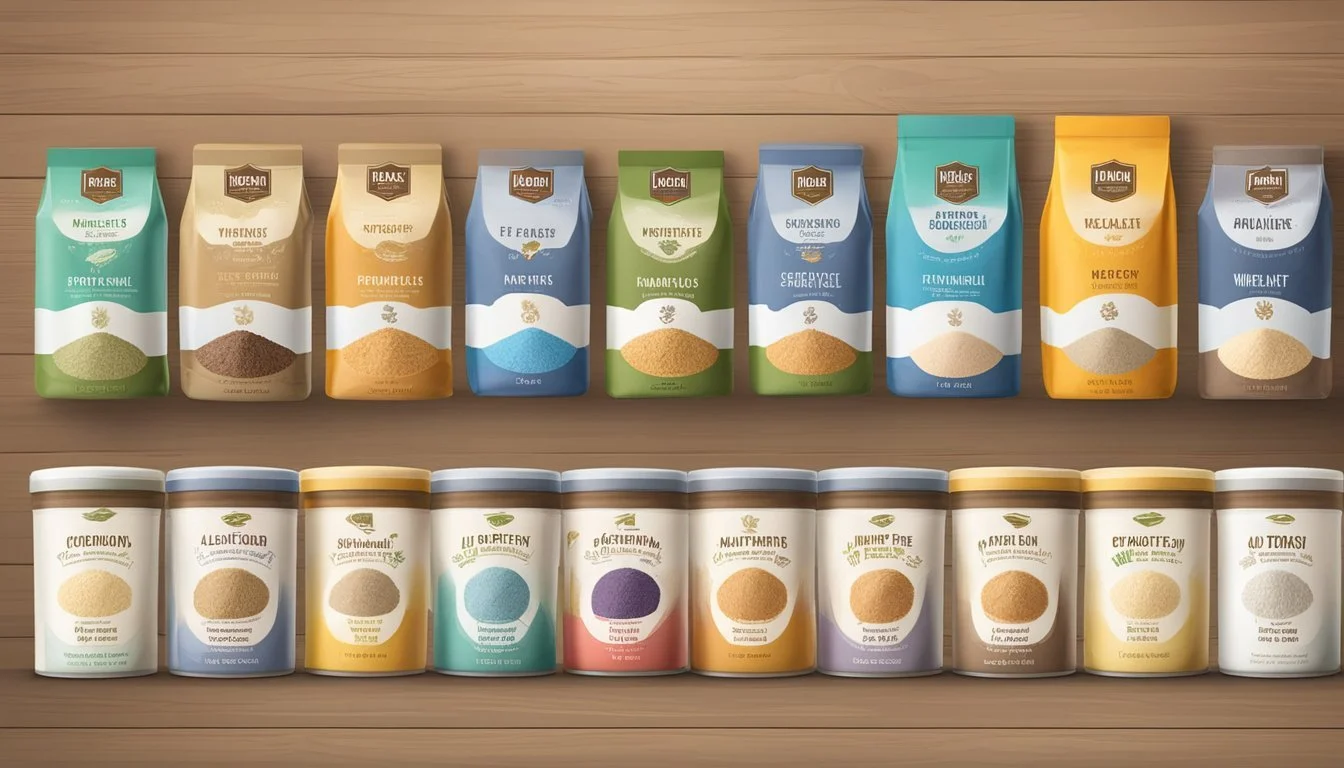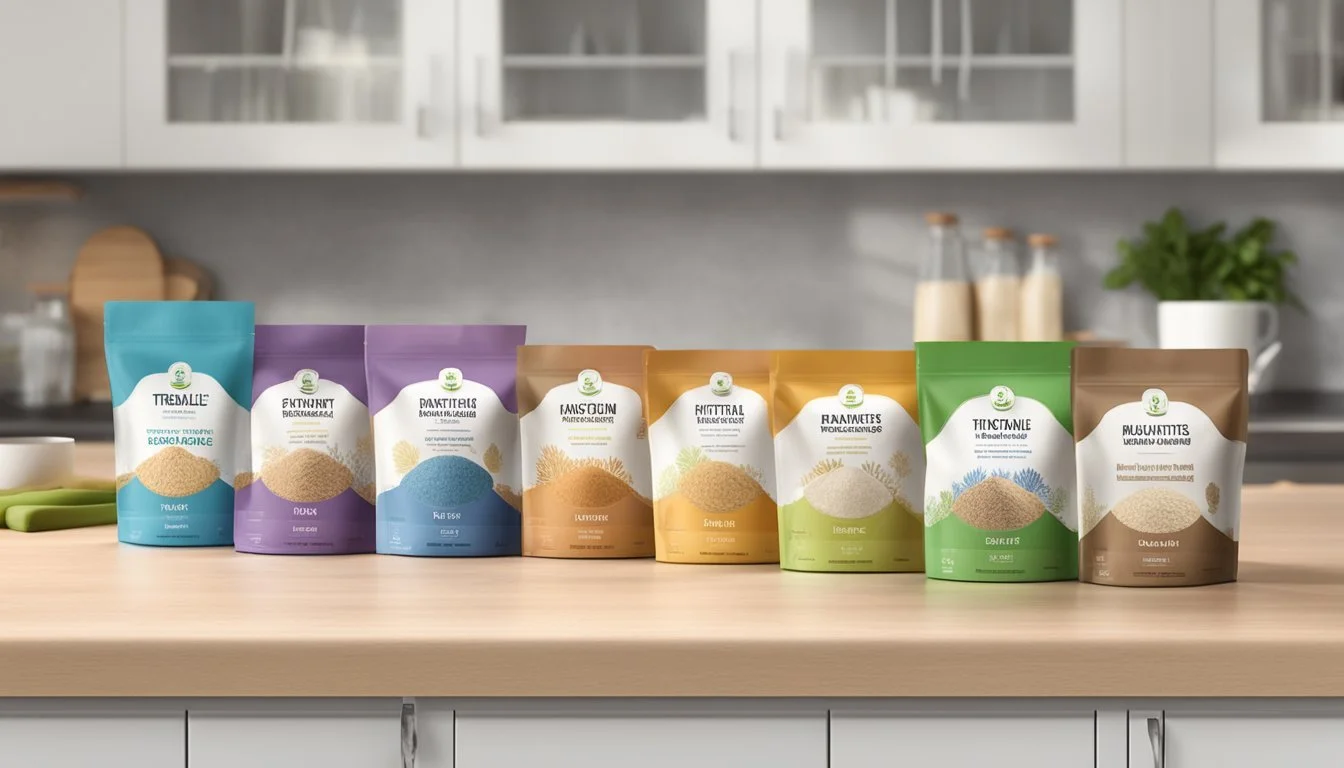Triticale Flour Substitutes
Best Alternatives for Baking Success
For those seeking alternatives to triticale flour, there are numerous substitutes that cater to different dietary needs without compromising taste and texture. Almond flour is a popular choice, noted for its low-carb profile and high nutritional value, making it suitable for gluten-free baking. Additionally, coconut flour offers a high-fiber and gluten-free option, ideal for adding a subtle sweetness to baked goods.
Another substitute includes rice flour, which provides a neutral flavor and a smooth texture, fitting effortlessly into many recipes. Sorghum flour is another excellent alternative, offering a mild taste while being packed with protein, fiber, and antioxidants. For those looking to enhance the nutritional content of their baked items, quinoa flour is highly recommended due to its rich protein content and essential amino acids.
These substitutes not only cater to gluten-free needs but also add unique flavors and nutritional benefits to your baking repertoire.
Understanding Triticale Flour
Triticale flour originates from a hybrid grain combining wheat and rye, designed to merge the benefits of both. It offers a nutritious profile and is versatile in baking and cooking applications.
Nutritional Profile of Triticale Flour
Triticale flour boasts a rich nutritional composition. It combines the high protein content of wheat with the robust dietary fiber of rye. This flour also contains essential nutrients such as iron, magnesium, and folic acid.
In terms of gluten, triticale has a moderate level, which gives it a unique balance between the structure-providing properties of wheat and the digestive benefits of rye. Protein content is significant, making it beneficial for those looking to increase their protein intake through grains.
Fiber content in triticale is notable, contributing to better digestion and prolonged satiety. It can be particularly attractive for those aiming to include more whole grains in their diets.
Common Uses in Baking and Cooking
Triticale flour is highly adaptable in both baking and cooking. It functions well as a partial substitute for wheat flour in various recipes. Common uses include making bread, tortillas, cakes, and cookies.
When used in bread-making, triticale can enhance the bread's texture and nutritional value. It works well in combination with other flours to create balanced and flavorful baked goods. Additionally, it's suitable for savory dishes, where its robust flavor can complement soups, stews, and casseroles.
In breakfast dishes, triticale grains can be cooked similarly to oatmeal, providing a nutritious and hearty start to the day. Its versatility extends to microwave preparation, offering a quick and convenient option for busy mornings.
Wheat and Gluten-Free Alternatives
For those avoiding gluten due to celiac disease or other dietary preferences, there are numerous versatile flour substitutes that can be used in place of triticale flour.
Rice Flour and Brown Rice Flour
Rice flour, derived from finely milled rice, is a common gluten-free flour. It provides a neutral flavor, making it suitable for various recipes. Brown rice flour, made from whole grain rice, offers more fiber and minerals compared to white rice flour.
Both types can replace wheat flour in baking, though brown rice flour adds a slightly nutty taste and denser texture. For optimal results, rice flours are often combined with other gluten-free flours to improve the texture and structure of baked goods.
Buckwheat Flour
Despite its misleading name, buckwheat flour is inherently gluten-free. It originates from ground buckwheat seeds and is rich in complex carbohydrates, protein, and essential minerals.
Its strong, earthy flavor works well in recipes such as pancakes, waffles, and yeast breads. Due to its robust nature, it is often used in combination with other gluten-free flours to balance its intense taste and to improve the texture of baked goods.
Sorghum Flour
Sorghum flour, made from the grinding of sorghum grains, is a staple in many gluten-free kitchens. It has a mild, slightly sweet flavor and a light color, making it versatile for various baking needs.
Rich in protein, fiber, and antioxidants, sorghum flour can improve the nutritional profile of baked goods. It performs best when combined with other flours and a binder, such as xanthan gum, to enhance the texture and structure of gluten-free recipes.
Quinoa Flour
Quinoa flour, produced from finely ground quinoa seeds, offers a distinctive, nutty flavor. It is gluten-free and packed with protein, fiber, and essential amino acids.
Ideal for more robust baked goods like breads and muffins, quinoa flour adds nutritional value and a unique taste. It is common to pair quinoa flour with other flours to maintain the desired consistency and reduce the grainy texture sometimes associated with its use.
Amaranth Flour
Amaranth flour stands out with its high protein content and impressive nutritional benefits, including calcium and iron. It possesses a mild, nutty flavor that works best when not used as the sole flour in a recipe.
Amaranth flour can replace up to 25% of all-purpose flour in various recipes, such as scones and pancakes, to bolster protein and nutrient content. It often requires blending with other gluten-free flours to achieve a balanced flavor and texture in baked items.
Nut and Seed Flour Substitutes
Nut and seed flours offer gluten-free alternatives with unique flavors and nutritional profiles. Common choices include almond flour and almond meal, coconut flour, and flaxseed meal, each of which brings distinctive properties to baked goods.
Almond Flour and Almond Meal
Almond Flour is made from blanched almonds that have been finely ground and sifted. It is a popular choice for gluten-free baking, offering a moist texture and subtle, nutty flavor. Almond flour is rich in protein, healthy fats, and vitamin E, making it a nutritious alternative to traditional flours. It works well in cakes, cookies, and quick breads.
Almond Meal, on the other hand, is less finely ground and may include almond skins. This gives it a coarser texture, which can add a pleasant crunch to baked goods like muffins and pancakes. Both almond flour and almond meal are low in carbs, making them suitable for low-carb and keto diets.
Coconut Flour
Coconut Flour is made from dried coconut meat and is exceedingly absorbent, often requiring additional liquid in recipes. It has a mild coconut flavor and is ideal for gluten-free and low-carb baking. High in fiber and low in carbs, coconut flour helps create light and soft textures in baked goods.
Due to its absorbency, coconut flour cannot be substituted on a 1:1 basis for regular flour. Typically, recipes will only need about 1/4 to 1/3 of the amount of coconut flour as they would regular flour. It is commonly used in cakes, muffins, and breads.
Flaxseed Meal
Flaxseed Meal is ground from whole flaxseeds and is an excellent source of omega-3 fatty acids, fiber, and protein. It has a mild, nutty flavor and can be used to add nutritional value to baked goods. Flaxseed meal is highly absorbent, so it often requires extra liquid in recipes.
It is frequently used as an egg substitute in vegan baking by mixing 1 tablespoon of flaxseed meal with 2.5 tablespoons of water to create a gel-like consistency. Flaxseed meal works well in bread, muffins, and pancakes as both a primary flour or supplement to other flours.
Root and Tubers as Flour Substitutes
Root and tuber-based flours, like cassava, potato, and arrowroot, offer versatile, gluten-free alternatives common in baking. These flours are often starchy and ideal for those needing gluten-free options. Here are specifics on each type:
Cassava Flour
Cassava flour is made from the root of the cassava plant. This flour is popular for being gluten-free and having a mild flavor, making it suitable for various recipes.
Cassava flour is known for being highly similar to wheat flour in terms of texture and performance. It can be used as a 1:1 substitute in many recipes, including bread, pancakes, and cookies. Nutritionally, it is high in carbohydrates and provides a decent amount of fiber.
Potato Flour
Potato flour is made by cooking, drying, and grinding potatoes. It has a strong potato flavor and is known for its high starch content.
This flour is excellent for gluten-free baking, contributing to a moist texture. It is also commonly used as a thickening agent in soups and sauces due to its thickening properties. When used in baking, it helps retain moisture, preventing dryness in gluten-free baked goods.
Arrowroot
Arrowroot flour is derived from the underground stems of the arrowroot plant. This starch is highly digestible and suitable for those who need easily digestible foods.
Arrowroot is often used as a thickening agent in cooking and baking due to its neutral flavor and clear thickening properties. It creates a glossy finish and is perfect for sauces, jellies, and puddings. It can also pair with other gluten-free flours for better texture in baked goods.
Legume-Based Flour Alternatives
Legume-based flours are excellent substitutes for triticale flour, particularly for those seeking gluten-free options with added nutritional benefits. They provide a good source of protein and nutrients, making them ideal for various recipes.
Chickpea Flour
Chickpea flour, made from ground chickpeas, is a popular gluten-free alternative. It contains higher levels of protein compared to many other flours, making it a nutritious option. When mixed with liquids, chickpea flour tends to become sticky, providing good binding properties in recipes.
In terms of flavor, chickpea flour has a mild, slightly nutty taste that complements both sweet and savory dishes. It is often used in recipes for pancakes, fritters, and gluten-free breads. The dense texture of chickpea flour can enhance the structure of baked goods.
The nutritional profile of chickpea flour is impressive. It is rich in essential nutrients such as folate, iron, and phosphorus. Additionally, chickpea flour offers dietary fiber, which aids in digestion and helps manage blood sugar levels. This makes it a valuable ingredient in health-conscious cooking.
Lentil Flour
Lentil flour, made from ground lentils, is another versatile legume-based flour. It is gluten-free and packed with protein, making it an excellent choice for adding nutritional value to recipes. Lentil flour has a fine texture and can be used to thicken soups, stews, and sauces.
The flavor of lentil flour is mild and earthy, which pairs well with both savory and sweet recipes. It works well in baking, particularly in muffins, breads, and crackers. Lentil flour's ability to absorb moisture makes it suitable for creating moist, dense baked goods.
From a nutritional standpoint, lentil flour is a powerhouse. It provides essential minerals like potassium, magnesium, and zinc. It is also high in dietary fiber, which supports gut health. The protein content in lentil flour helps in maintaining muscle mass and promoting satiety, making it a beneficial addition to a balanced diet.
Other Grain Flour Substitutes
Exploring alternatives to traditional wheat flour can provide unique flavors and nutritional benefits. Among the many options available, the following grains stand out for their versatility and health benefits.
Corn Flour and Cornmeal
Corn Flour and Cornmeal are commonly used substitutes that differ primarily in texture.
Corn flour is finely ground, whereas cornmeal is coarser. These flour alternatives are rich in iron and provide a distinct taste to baked goods. Cornmeal is often used in cornbread and muffins, creating a grainy texture. Corn flour, being finer, works well for tortillas and other flatbreads.
Nutritional Benefits:
High in B vitamins.
Contains beneficial antioxidants.
Both can be used in gluten-free baking but should be combined with other flours for better texture and structure.
Millet Flour
Millet Flour is a nutritious, gluten-free alternative with a slightly sweet, nutty flavor.
It is high in magnesium, iron, and B vitamins, offering significant health benefits. This flour is excellent for bread and muffins, providing a delicate crumb. Due to its light nature, it's recommended to mix millet flour with denser flours like brown rice flour for structure.
Uses:
Muffins
Quick breads
Pancakes
By combining millet with other grains, you ensure a balanced texture and nutritional profile.
Spelt Flour
Spelt Flour is an ancient grain that is more digestible than modern wheat.
Although it contains gluten, its protein structure is easier to digest. This flour has a sweet, mildly nutty flavor and is versatile in baking. It's perfect for bread, cookies, and pasta, offering a similar taste and structure to whole wheat flour but with a softer texture.
Key Points:
Higher in protein than conventional wheat.
Rich in fiber and minerals like iron.
Spelt flour can be used 1:1 for whole wheat flour but may require slightly less liquid in recipes.
Barley Flour
Barley Flour is made from ground barley grain and contains fiber and essential nutrients like selenium and iron.
It has a mild, nutty flavor and is often used to enhance the texture and flavor of baked goods. Barley flour works well in combination with other flours, as it helps maintain moisture in baking.
Applications:
Cookies
Pancakes
Quick breads
By integrating barley flour into baking, one can benefit from its unique nutritional profile while enjoying improved moisture and texture.
Baking Considerations and Adjustments
When substituting triticale flour, attention to moisture, fat content, texture, flavor, and binding agents is crucial to ensure successful baking results. Each aspect requires specific adjustments to balance the overall quality of the baked goods.
Managing Moisture and Fat Content
Triticale flour has a different moisture absorption rate compared to other flours. Adjusting liquid levels in recipes is critical. Triticale flour tends to absorb less water, so reducing added liquids by 10-15% can help maintain the correct consistency.
Additionally, triticale flour has a lower fat content. Incorporating an extra teaspoon of oil or butter per cup of flour can offset this difference. These adjustments ensure that the baked goods do not become too dry or dense.
Adjusting Recipes for Texture and Flavor
The texture of triticale flour-based products can be slightly denser and grittier than those made with wheat flour. Adding an extra egg or egg white can lighten the texture. It's helpful for achieving a consistency closer to traditional wheat flour products.
Flavor-wise, triticale has a mild, slightly nutty taste. This can complement many recipes but might need balancing. Consider adding a small amount of sugar or a pinch of salt to adjust the overall flavor profile to your liking.
Use of Binding Agents
Triticale flour doesn't have the same gluten structure as wheat flour, impacting the binding properties in baking. For recipes that require strong binding, adding xanthan gum or guar gum can help. Typically, 1/2 teaspoon per cup of triticale flour is sufficient.
If gluten-free baking is required, using a combination of triticale flour and other gluten-free flour substitutes, along with binding agents, can improve the texture and stability of baked goods. Egg replacers can also serve as effective binding agents in vegan recipes.
Through these specific modifications, triticale flour can be successfully used as a substitute while preserving the desired qualities of the final baked product.
Health Considerations of Flour Substitutes
Flour substitutes offer a variety of health benefits and cater to different dietary needs, such as gluten-free options and enhanced nutrient profiles. These alternatives can impact digestion, blood sugar levels, and potential allergies differently from traditional wheat flour.
Dietary Fibers and Digestive Health
Flour substitutes often contain higher levels of dietary fibers compared to traditional wheat flour. For instance, oat flour is rich in soluble fiber, which can aid in digestive health by promoting regular bowel movements and preventing constipation. Almond flour and brown rice flour are also notable for their fiber content, contributing to a healthier gut microbiome.
The increased fiber can also help in maintaining a feeling of fullness, which can be beneficial for weight management. However, excessive fiber intake can lead to digestive discomfort, so it’s crucial to balance the intake of high-fiber flours.
Impact on Blood Sugar and Carbohydrate Intake
The glycemic index (GI) of flour substitutes can vary significantly, affecting blood sugar levels. Flours like almond flour and coconut flour are low in carbohydrates and have a lower GI, which can help in managing blood sugar spikes, making them suitable for people with diabetes or those on low-carb diets.
In contrast, flours such as rice flour have a higher GI and can cause a quicker rise in blood sugar. Balancing these substitutes with other low-GI foods can mitigate potential blood sugar spikes. Monitoring carbohydrate intake is essential for individuals with diabetes or those managing their blood sugar levels.
Allergic Reactions and Sensitivities
Allergic reactions and food sensitivities can vary with different flour substitutes. Individuals with nut allergies should avoid almond flour, while those with Celiac disease must choose flours that are gluten-free. Amaranth flour and brown rice flour are excellent gluten-free options that provide nutritional benefits without triggering gluten sensitivities.
It is important to check for any potential allergens listed on the packaging of flour substitutes. Introducing new substitutes slowly into the diet can help in identifying any adverse reactions.
Balancing dietary needs carefully can lead to a healthier and more inclusive approach to meal preparation.









